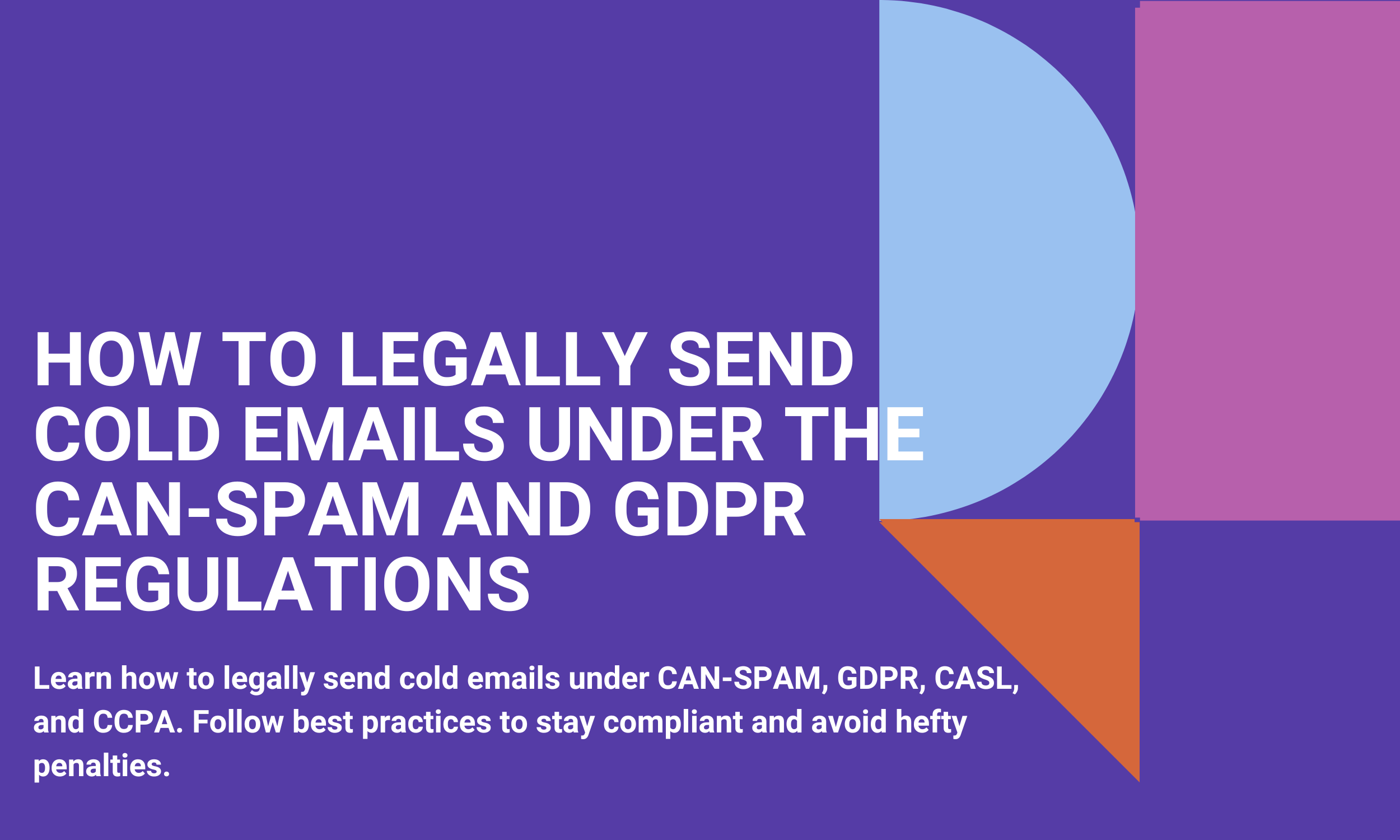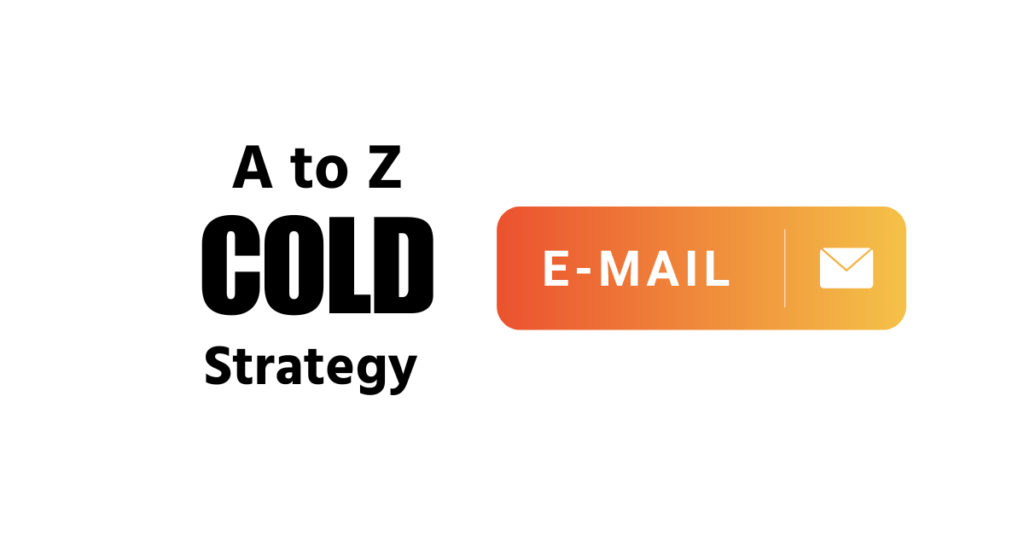Cold email legal compliance involves adhering to laws like GDPR and CAN-SPAM. These laws regulate how businesses can contact individuals via email.
Cold emailing can be an effective marketing strategy, but it must comply with legal standards. GDPR in Europe and CAN-SPAM in the U. S. Are key regulations governing email communication. These laws require businesses to obtain consent and provide clear opt-out options.
Failing to comply can result in hefty fines and damage to your reputation. It’s crucial to understand and follow these guidelines to ensure your cold emails are both effective and legal. Proper compliance not only protects your business but also builds trust with your audience, enhancing your overall marketing efforts.
Table of Contents
Introduction To Cold Emailing
Cold emailing is a powerful tool in the digital marketing world. It involves sending unsolicited emails to potential clients or customers. These emails aim to establish a business relationship. Understanding cold emailing is crucial for business growth. This section will introduce you to the concept and importance of cold emailing.
What Is Cold Emailing?
Cold emailing is the practice of sending emails to recipients who do not know you. It is different from spam as it targets specific individuals. The goal is to create a connection and generate business leads.
Here are some key points to understand cold emailing:
- It is personalized and relevant to the recipient.
- It aims to engage and interest the recipient.
- It follows legal and ethical guidelines.
Importance In Business
Cold emailing plays a significant role in business growth. It helps in reaching out to new potential customers. It is cost-effective and scalable. Companies use cold emailing to expand their network and market.
Here are some benefits of cold emailing for businesses:
- Cost-effective way to reach a broad audience.
- Generates leads and builds relationships.
- Increases brand awareness and visibility.
| Benefits | Details |
|---|---|
| Cost-effective | Reaches many people with minimal cost. |
| Generates Leads | Identifies potential clients for future business. |
| Increases Brand Awareness | Promotes your brand to a wider audience. |
Cold emailing can be an effective strategy when used correctly. It is important to follow legal guidelines to avoid penalties. This ensures a positive reputation for your business. Cold emailing is vital for success in sectors like business brokering, manufacturing, SaaS, financial advising, and recruiting.
Legal Frameworks
Understanding the legal frameworks for cold email compliance is crucial. This ensures your business operates within the law. It also protects your reputation. Let’s explore key regulations.
Can-spam Act
The CAN-SPAM Act sets the rules for commercial emails in the U.S. It gives recipients the right to stop receiving emails. Businesses must follow these rules:
- Avoid using false or misleading headers.
- Do not use deceptive subject lines.
- Identify the message as an ad.
- Include your physical postal address.
- Provide a way to opt-out of emails.
- Honor opt-out requests promptly.
- Monitor what others do on your behalf.
Gdpr Regulations
The General Data Protection Regulation (GDPR) applies to emails sent to EU residents. It focuses on protecting personal data. Key requirements include:
- Obtain explicit consent before sending emails.
- Keep records of consent.
- Provide an easy opt-out option.
- Ensure data security and privacy.
- Notify authorities of data breaches promptly.
Non-compliance can result in heavy fines. It’s important to follow these rules.
| Regulation | Key Requirements | Penalties |
|---|---|---|
| CAN-SPAM Act | No false headersHonest subject linesOpt-out options | Up to $43,280 per email |
| GDPR | Explicit consentData securityOpt-out options | Up to €20 million or 4% of global revenue |
Obtaining Consent
Obtaining consent is crucial for cold email legal compliance. It ensures you respect privacy and build trust. This section will guide you through effective methods to obtain consent.
Opt-in Methods
Using opt-in methods is essential to gather consent. Here are some methods:
- Single Opt-In: Users sign up once without additional verification.
- Double Opt-In: Users confirm their subscription via email. This verifies their interest.
- Pre-Ticked Boxes: Avoid using pre-ticked boxes. Always let users actively choose.
Maintaining Consent Records
Maintaining consent records is important for compliance. Keep detailed records of:
- Date of Consent: Record the date users gave consent.
- Method of Consent: Note how consent was obtained (e.g., form, email).
- Proof of Consent: Store the actual consent (e.g., consent form copies).
Here’s a simple table to organize your consent records:
| Consent Date | Method | Proof |
|---|---|---|
| 2023-10-01 | Form Submission | Form ID: 1234 |
| 2023-10-02 | Email Confirmation | Email ID: 5678 |
Regularly update and audit your consent records. This ensures ongoing compliance and builds user trust.
Email Content Guidelines
Understanding email content guidelines is crucial for cold email legal compliance. This section will help you craft emails that respect the law and your recipients. Follow these rules to avoid penalties and maintain a good reputation.
Accurate Subject Lines
Your subject lines must be honest and clear. Deceptive subject lines can mislead recipients and violate legal standards.
- Keep it simple and relevant.
- Avoid using false promises.
- Reflect the content of the email.
For example, do not use “Win a Free iPhone” if there is no contest. Instead, use “Special Offer on Our Latest Products”.
Clear Sender Information
Always provide clear sender information in your emails. This helps recipients know who sent the email and how to contact you.
- Include your name and business name.
- Provide a valid physical address.
- Add a clear reply-to email address.
For instance, your sender information could look like this:
| Field | Information |
|---|---|
| Name | John Doe |
| Business Name | Doe Enterprises |
| Address | 123 Business St, Suite 100, City, State, ZIP |
| Reply-To | contact@doeenterprises.com |
This ensures transparency and builds trust with your recipients. By following these guidelines, you comply with the law and respect your audience.
Read More – Spintax Explained: How to Supercharge Your Cold Emails in 2024
Unsubscribe Mechanisms
Ensuring compliance with cold email laws requires a clear Unsubscribe Mechanism. This allows recipients to opt-out easily. A seamless unsubscribe process builds trust and reduces spam complaints.
Easy Opt-out Process
An easy opt-out process is vital for legal compliance. Make the unsubscribe link visible and simple to use. Users should not struggle to find this option.
Here are some tips to ensure an easy opt-out process:
- Place the unsubscribe link at the bottom of the email.
- Use clear and straightforward language like “Unsubscribe” or “Opt-Out”.
- Ensure the link directs to a one-click unsubscribe page.
Avoid using complicated processes that could frustrate users. A simple opt-out process enhances user trust and keeps your emails compliant with laws.
Prompt Unsubscribe Handling
Handling unsubscribe requests promptly is crucial. Delays can lead to legal issues and unhappy recipients.
Follow these steps to ensure prompt unsubscribe handling:
- Automate the unsubscribe process to remove users immediately.
- Confirm the unsubscription with a polite email.
- Do not send any more emails after the unsubscribe request.
Here’s a table summarizing key points for prompt unsubscribe handling:
| Action | Details |
|---|---|
| Automation | Use software to remove users instantly. |
| Confirmation | Send a polite confirmation email. |
| Compliance | Stop all emails after the unsubscribe. |
By ensuring a smooth and prompt unsubscribe mechanism, you respect user preferences and stay compliant with the law.

Credit: velocitymedia.agency
Data Protection Practices
Data protection is key to cold email legal compliance. Adhering to data protection practices ensures the safety of personal information. This section covers secure data storage and third-party data sharing.
Secure Data Storage
Storing data securely is crucial. Encrypt data to keep it safe. Use strong passwords for all accounts. Regularly update your security software. Limit access to sensitive data. Only authorized personnel should handle it. Always back up your data.
| Practice | Description |
|---|---|
| Encryption | Convert data into a secure code. |
| Strong Passwords | Use complex and unique passwords. |
| Security Software | Regularly update antivirus and firewall. |
| Access Control | Restrict data access to authorized staff. |
| Data Backup | Regularly back up your data. |
Third-party Data Sharing
Sharing data with third parties needs caution. Only share data with trusted partners. Ensure third parties comply with data protection laws. Use data-sharing agreements to define responsibilities. Regularly audit third-party data practices. Always inform users before sharing their data.
- Share data with trusted partners only.
- Ensure third-party compliance with data laws.
- Use data-sharing agreements.
- Audit third-party data practices regularly.
- Inform users before sharing data.
Monitoring And Compliance
Ensuring that your cold email campaigns are legally compliant is crucial. Regular monitoring helps you stay within legal boundaries. Compliance prevents penalties and maintains your reputation.
Regular Audits
Regular audits are necessary for maintaining email compliance. These audits help identify any potential issues early. Addressing issues promptly avoids legal problems.
During an audit, check the following:
- Consent records
- Unsubscribe mechanisms
- Email content for misleading information
Keeping detailed records of audits is important. It shows your commitment to compliance.
Compliance Training
Training your team on compliance is vital. Ensure everyone understands the legal requirements. Regular training sessions keep your team updated on changes.
Key topics for training include:
- Consent requirements
- Data privacy laws
- Penalties for non-compliance
Providing written materials can reinforce training. Encourage your team to ask questions. This ensures they grasp the concepts fully.
Benefits Of Monitoring And Compliance
Monitoring compliance prevents legal issues. It also improves customer trust. A compliant email campaign is more effective and respected.
Consider implementing a compliance checklist. This helps ensure all steps are covered:
| Task | Frequency |
|---|---|
| Consent Verification | Monthly |
| Content Review | Weekly |
| Unsubscribe Process Check | Quarterly |
In summary, regular audits and compliance training are essential. These steps help maintain legal compliance. They also protect your business and reputation.

Credit: hunter.io
Penalties For Non-compliance
Ignoring legal guidelines for cold emails can lead to severe consequences. Businesses must understand these penalties to avoid costly mistakes.
Fines And Legal Actions
Non-compliance with cold email laws can result in hefty fines. The CAN-SPAM Act in the United States imposes fines up to $43,280 per email. European companies face penalties under the GDPR, which can be up to 20 million euros or 4% of annual turnover.
Here is a breakdown of potential fines:
| Regulation | Maximum Fine |
|---|---|
| CAN-SPAM Act | $43,280 per email |
| GDPR | 20 million euros or 4% of annual turnover |
Legal actions may include lawsuits from recipients. These actions can be costly and damage your business financially.
Reputation Damage
Non-compliance can tarnish your business reputation. Customers value privacy and respect. Sending unsolicited emails can harm trust.
Consider these potential impacts on your reputation:
- Loss of customer trust
- Negative online reviews
- Social media backlash
Maintaining compliance helps protect your brand image. It also ensures better customer relationships and long-term success.
Best Practices For Success
Cold emailing can be an effective tool for reaching potential clients. To ensure success, it’s crucial to follow best practices. Adhering to these strategies not only enhances your chances of engagement but also keeps you legally compliant.
Personalization Strategies
Personalization is key in cold emailing. Tailor each email to the recipient.
- Use their name in the greeting.
- Reference their company or industry.
- Mention any recent achievements or news related to them.
Personalized emails show you value the recipient. They are more likely to respond.
Timing And Frequency
Timing and frequency play a vital role in email success.
| Best Time to Send | Reason |
|---|---|
| Tuesday, 10 AM | Most people check emails in the morning. |
| Thursday, 2 PM | Mid-week is less busy. |
Avoid sending more than two emails per week. Too many emails can annoy recipients.
- First email: Introduction and value proposition.
- Follow-up: Gentle reminder and additional value.
Space your emails to avoid overwhelming your audience.
Read Further – Effective Strategies to Send Bulk Cold Emails Without Getting Blacklisted in 2024
Frequently Asked Questions
What Is Cold Email Legal Compliance?
Cold email legal compliance refers to following laws and regulations when sending unsolicited emails. This includes obtaining consent and providing opt-out options.
Are Cold Emails Legal?
Yes, cold emails are legal if you follow regulations. Ensure you have consent, identify yourself, and include an opt-out option.
How To Ensure Cold Email Compliance?
To ensure compliance, follow laws like CAN-SPAM or GDPR. Obtain consent, provide clear identification, and include an easy opt-out mechanism.
Do I Need Consent For Cold Emails?
Yes, consent is crucial for cold emails. Under GDPR, explicit consent is required. CAN-SPAM requires an opt-out option.
Conclusion
Ensuring legal compliance in cold emailing is crucial. It protects your business and builds trust. Follow regulations, get proper consent, and respect opt-outs. This will improve your email campaigns’ effectiveness. Stay updated with laws to avoid penalties. Legal compliance makes your cold emailing efforts more successful and ethical.



